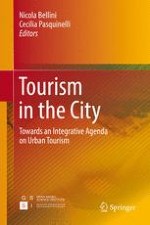2017 | OriginalPaper | Chapter
A “New Normality” for Residents and Tourists: How Can a Disaster Become a Tourist Resource?
Authors : Silvia Mugnano, Fabio Carnelli
Published in: Tourism in the City
Publisher: Springer International Publishing
Activate our intelligent search to find suitable subject content or patents.
Select sections of text to find matching patents with Artificial Intelligence. powered by
Select sections of text to find additional relevant content using AI-assisted search. powered by
